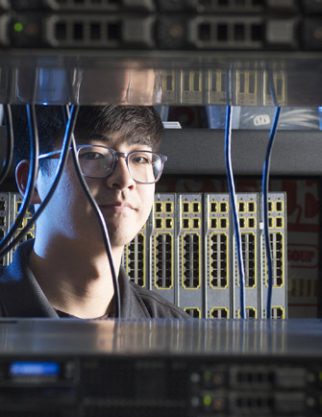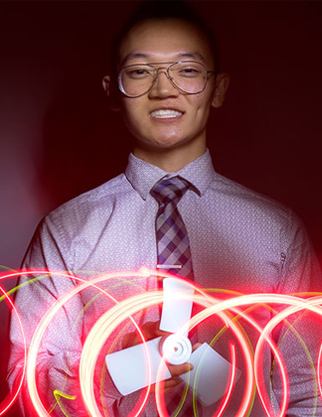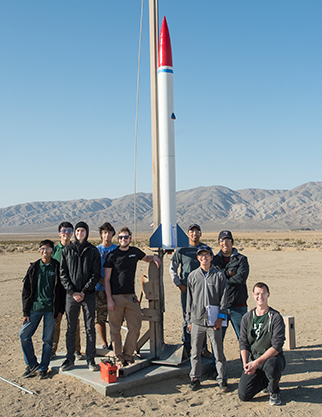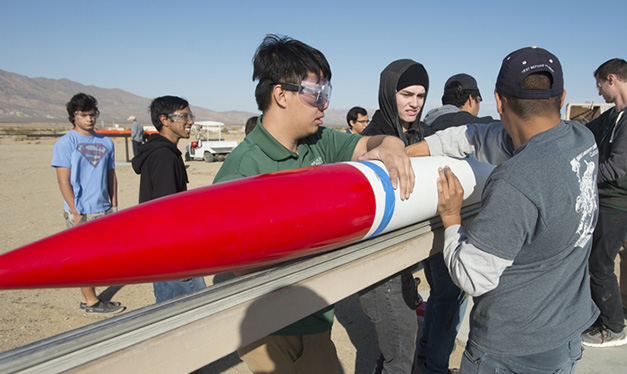The
Right
Stuff
Preparing
for the
modern-day
space race
Cal Poly Pomona is launching its Liquid Rocket Lab just as a new space race begins. That race is not between governments, but among private companies vying to dominate the rapidly-expanding business of commercial flight.
Corporations such as SpaceX, Blue Origin, Bigelow Aerospace and others are developing rockets for a variety of purposes, from transporting supplies to the International Space Station to sending tourists to Mars.
SpaceX made history in February with the successful maiden flight of its Falcon Heavy rocket, which the company says is the world’s most powerful rocket by a factor of 2. Immediate plans include a mission to fly two tourists around the moon and a long-term goal of helping humans live on other planets.
As private companies push the boundaries of technology, Cal Poly Pomona’s Liquid Rocket Lab is positioning students to join the swiftly evolving aerospace industry by providing them hands-on experiences on campus in modern rocketry.
It’s an exciting time for rocketry and spaceflight, says Edwin Betady, a junior studying aerospace engineering who heads the project’s mobile rocket engine test stand team. And helping build the university’s first liquid-fueled rocket, Bronco 1, is great preparation for the opportunities to come.
“SpaceX and Elon Musk are kind of opening the doors to space and commercializing space and making it more accessible. That’s made it more interesting to be involved in propulsion.”
“SpaceX and Elon Musk are kind of opening the doors to space and commercializing space and making it more accessible. That’s made it more interesting to be involved in propulsion because before it was just NASA,” Betady says. “Now it’s becoming a norm. So being involved in something like Bronco 1 gives you hope for getting involved in some of those projects as well.”
Richard Picard, the student project leader, shares Betady’s optimism about students’ job prospects in the aerospace industry.
“For so long, it was just governments doing it. But now, there are companies out there that are willing to fly people to space, like Virgin Orbit,” says Picard, a senior double majoring in aerospace engineering and physics. “To see that emerge is really inspiring because maybe we’re going to get a chance to work in that someday.”
In keeping with the latest technological trends, the rocketry students have chosen the cutting-edge industry standard, liquid methane, to power Bronco 1.
Methane is an environmentally safer choice and less expensive than liquid hydrogen, according to Aerospace Engineering Professor Steven Dobbs, one of a half-dozen faculty advisors on the project. While hydrogen is generally produced through expensive and energy-intensive industrial processes, methane is abundantly available in the environment as natural gas.
SpaceX’s new Raptor engine, which will power the company’s upcoming BFR Mars rocket (Big Falcon Rocket), and an in-development NASA planetary lander prototype called Project Morpheus will both use liquid methane.
With the eyes of many planetary explorers firmly set on Mars, Picard says enthusiasm for methane-fueled spacecraft has grown following the recent discovery of the gas on the Red Planet.
“Since you have CO2 in the atmosphere and methane on the surface, you can make a limited amount of fuel once you get there,” he says. “As far as future space exploration goes, that would be a big, big bonus to be able to land on Mars, get your fuel there, then take off and go somewhere else.”
“As far as future space exploration goes, that would be a big, big bonus to be able to land on Mars, get your fuel there, then take off and go somewhere else.”
Throughout the Liquid Rocketry Lab, faculty are working to instill “system engineering discipline,” which includes understanding requirements, risk analysis, risk mitigation and contingency planning.
“We’re trying to teach the students how to do it in the industry, not as amateurs,” Dobbs says.
Andres Colon, a sophomore studying computer engineering who is working on the rocket’s electrical systems, practices that discipline in the lab.
“It’s neat seeing the stuff from classes meld with the real world,” he says, while making adjustments to a system of sensors to monitor the temperature of the cryogenic liquid methane fuel. The fuel is stored at temperatures exceeding 250 degrees below 0.
“There’s so much testing,” Colon says. “It’s tedious, but it’s essential to make parts work. I’ve honestly learned a lot.”
Published May 17, 2018













